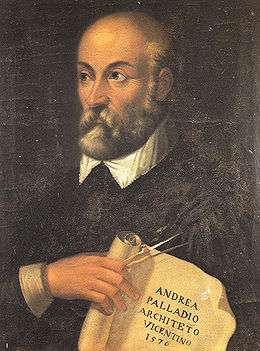Villa Cornaro
Villa Cornaro is a patrician villa in Piombino Dese, about 30 km northwest of Venice, Italy. It was designed by the Italian Renaissance architect Andrea Palladio in 1552 and is illustrated and described by him in Book Two of his 1570 masterwork, I quattro libri dell'architettura (The Four Books on Architecture).[1]
| UNESCO World Heritage Site | |
|---|---|
 Villa Cornaro | |
| Location | Piombino Dese, Province of Venice, Veneto, Italy |
| Part of | City of Vicenza and the Palladian Villas of the Veneto |
| Criteria | Cultural: (i), (ii) |
| Reference | 712bis-023 |
| Inscription | 1994 (18th session) |
| Extensions | 1996 |
| Coordinates | |
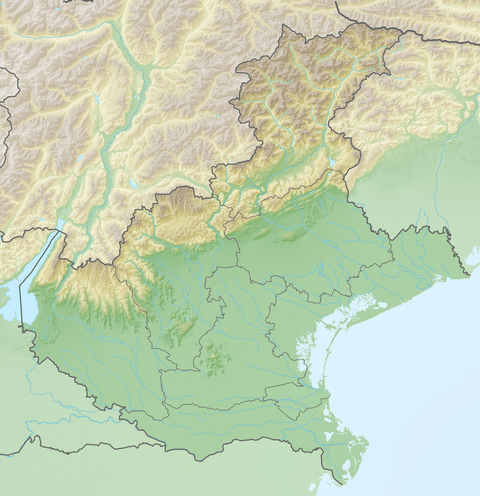 Location of Villa Cornaro in Veneto  Villa Cornaro (Italy) | |
Architecture
Villa Cornaro was mainly constructed in 1553–1554, with additional work into the 1590s, after Palladio had died, for Giorgio Cornaro, younger son of a wealthy family.[2] It represents one of the most exemplary illustrations of a Renaissance villa during this time frame. The north façade has an innovative projecting central portico-loggia that is a flexible living space out of the sun and open to cooling breezes. The interior space is a harmonious arrangement of the strictly symmetrical floor plans on which Palladio insisted without exception. Rooms of inter-related proportions composed of squares and rectangles flank a central axial vista, which extends through the house. As Rudolph Wittkower noted,[3] by moving subsidiary staircases into the projecting wings and filling matching corner spaces with paired oval principal stairs, space was left for a central salone, which is fully as wide as the porticos. The central core of the villa forms a rectangle in which there are six repetitions of an elegant standard module. The interior has 18th-century frescos by Mattia Bortoloni and stuccos by Camillo Mariani.
Influence
Through its illustration in Palladio's I quattro libri dell'architettura, in the 18th century Villa Cornaro became a model for villas all over the world, particularly in England Marble Hill House (1724–29)[4] in Twickenham, Middlesex, and in colonial America Drayton Hall (1738–1742) in Charleston, South Carolina, and Thomas Jefferson's initial version of Monticello (1768–1770) are early examples of its influence.
Conservation
Richard Rush purchased the Villa Cornaro in 1969 from an organization of the Italian Government dedicated to preserving the national monuments of Italy in the Veneto (L'Ente per le Ville Venete). He and his wife, Julia, restored the villa and furnished it with antiques over a period of twenty years. Since 1996 the villa has been conserved as part of a World Heritage Site "City of Vicenza and the Palladian Villas of the Veneto".
The villa is owned by Carl and Sally Gable, of Atlanta, Georgia, who purchased it in 1989 for $2 million from Dr. Rush. In 2017, the couple put up the villa for sale; the asking price was 35 million British pounds.[5]
Gallery
 Retro
Retro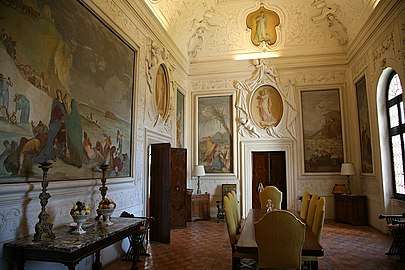
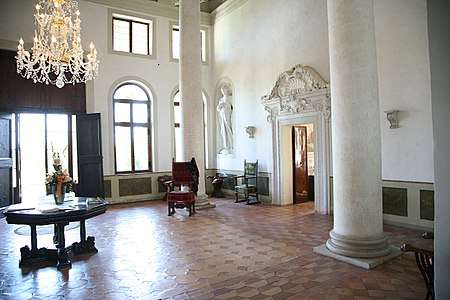 Main Hall
Main Hall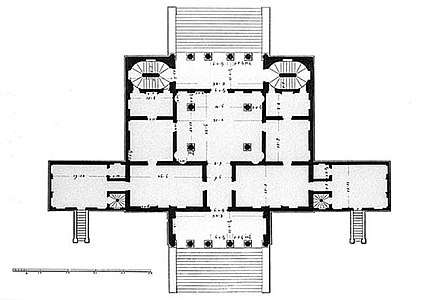 Ground plan by Bertotti Scamozzi, 1781
Ground plan by Bertotti Scamozzi, 1781
See also
| Wikimedia Commons has media related to Villa Cornaro. |
- Palladian architecture
- Palladian Villas of the Veneto
Notes
- Andrea Palladio, The Four Books on Architecture, translated by Robert Tavernor and Richard Schofield (Cambridge, Massachusetts: MIT Press, 2002) bk. 2, ISBN 0-262-66133-0.
- Douglas Lewis, "Freemasonic Imagery in a Venetian Fresco Cycle," in Hermeticism and the Renaissance, edited by Ingrid Merkel and Allen G. Debus(Washington, D. C.: Folger Shakespeare Library, 1988), p. 366, ISBN 0-918016-85-1.
- Wittkower, Architectural Principles in the Age of Humanism (London: Tiranti) 1962:72.
- "RIBA "Palladio and Britain"". Archived from the original on 2014-02-21. Retrieved 2014-02-04.
- Sally Gable and Carl I. Gable, Palladian Days: Finding a New Life in a Venetian Country House (New York: Alfred A. Knopf, 2005), ISBN 1-4000-4337-9
External links
- "Palladio and the Veneto" a catalogue of the villas maintained by www.cisapalladio.org. (in English and Italian)
- Palladio's Italian Villas (Villa Cornaro-Gable)
- "The Secrets of Palladio's Villas", Carl I. Gable
- Center for Palladian Studies in America, Inc.
